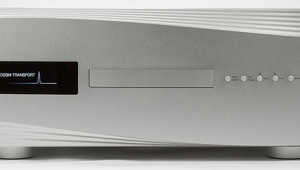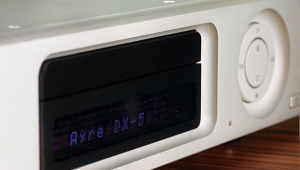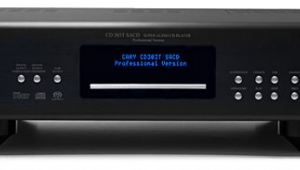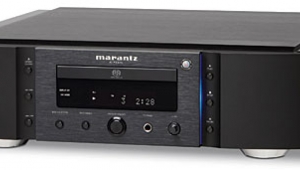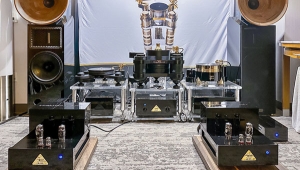| Columns Retired Columns & Blogs |
Meridian Digital Theatre surround-sound music system Measurements 800 part 2
But the upper trace shows what happened when I increased the level to "87." The top of the wave in each cycle hard-clips, I assume in the digital filter (a sinewave at the same peak level is reproduced without problem), followed by some full-level RF oscillation. It is extremely unlikely that the Meridian will ever display this tweeter-destroying behavior on 96kHz-sampled music, but perhaps it would be a good idea to keep the volume control below "87."
Channel separation revealed the usual 6dB/octave decrease with frequency, due to capacitive coupling between the channels, but was still better than 100dB below 3.5kHz with respect to left-to-right leakage. However, crosstalk was 20dB worse in the other direction from both balanced and unbalanced outputs.
Fig.4 shows a 1/3-octave spectral analysis of the 800's balanced output as it decoded CD data representing a dithered 1kHz tone at -90dBFS. The noise floor is free from power-supply or harmonic spuriae, and there is a very slight negative error visible. Extending the measurement bandwidth to 200kHz and playing data representing a 1LSB DC offset gave the spectrum shown in fig.5. The rise in ultrasonic noise due to the Bitstream D/A converter's noise-shaping is only moderate, and the overall noise floor is low in level.
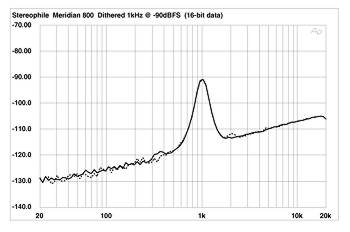
Fig.4 Meridian 800, 1/3-octave spectrum of dithered 1kHz tone at -90dBFS, with noise and spuriae (16-bit data). (Right channel dashed.)
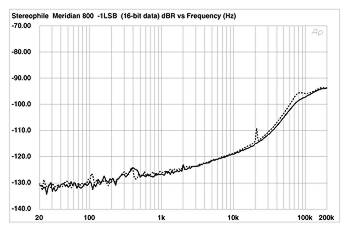
Fig.5 Meridian 800, 1/3-octave spectrum of -1LSB, with noise and spuriae, 16-bit data. (Right channel dashed.)
The linearity (fig.6) is basically excellent, but with a slight negative error apparent in the -90dB region. The player's reproduction of an undithered 16-bit/1kHz sinewave at -90.31dBFS (fig.7) is correspondingly superb, the three discrete voltage levels clearly visible. Harmonic and intermodulation distortions (figs.8 and 9, respectively) were also very low in level---at the resolving limit of the Audio Precision System One, in fact.
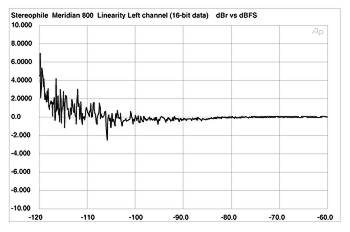
Fig.6 Meridian 800, left-channel departure from linearity, 16-bit data. (2dB/vertical div.)
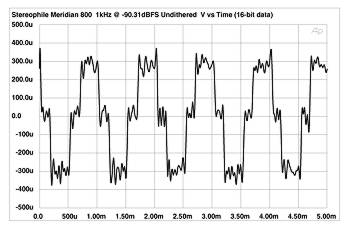
Fig.7 Meridian 800, waveform of undithered 1kHz sinewave at -90.31dBFS, 16-bit data.

Fig.8; 0Meridian 800, balanced spectrum of 50Hz sinewave, DC-1kHz, at 0dBFS into 100k ohms (linear frequency scale).

Fig.9 Meridian 800, balanced HF intermodulation spectrum, DC-22kHz, 19+20kHz at 0dBFS into 100k ohms (linear frequency scale).
As with the other Meridian digital gear I have examined, word-clock jitter was also superbly low. The Miller Audio Research Jitter Analyzer gave a figure of 144.7 picoseconds peak-peak, which is very low. And as can be seen in fig.10, all the data-related jitter sidebands (red numeric markers) lie below -121dBFS, with the noise floor at or below -130dBFS---the lowest I have ever measured on this test.

Fig.10 Meridian 800, high-resolution jitter spectrum of analog output signal (11.025kHz at -6dBFS with LSB toggled at 229Hz). Center frequency of trace, 11.025kHz; frequency range, ±3.5kHz.
Finally, although it uses a DVD transport, the Meridian 800 will play CD-Rs. Its error correction was excellent, the 800 playing without dropouts through track 35 of the Pierre Verany test CD, which has 2.4mm-long gaps in its pit spiral.
I understand that all the current Meridian 800-series digital components and DSP-series loudspeakers use D/A stages similar to that in the 800, so this set of measurements should be representative of all these components. Other than the volume-control idiosyncrasy with 96kHz-sampled material, the 800's measured performance represents the current state of the art.---John Atkinson
- Log in or register to post comments

